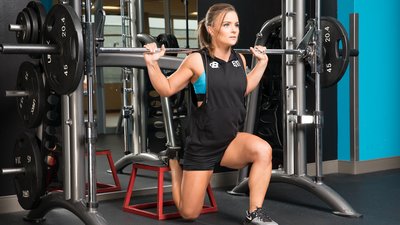If you want to get the most out of the foundational movement patterns, you have more options than simply adding another heavy set of 8-10…and another one, and another.
Contrary to popular belief, that so-called "hypertrophy rep range" is just one of many rep ranges that will get the job done. And, strategically stepping outside of it might be just the thing to help you add new muscle and develop strength, without wrecking your joints in the process.
One of my favorite ways to mix it up is using what I call "polarizing strength-stamina schemes," or SSS. In this approach, you train the same movement pattern twice in the same workout, back-to-back, but with very different parameters.
Start off going hard and heavy in traditional strength-based loading and programming, then finish off with a fiery metabolic stress-based bodyweight finisher for one single balls-to-the-wall challenge set.
The result is both brutally tough, and still extremely joint friendly. And, it may be just the thing you need to break through muscle and strength plateaus while learning a little about your ability—or lack thereof—to push the pedal to the floor in your training.
Here are three of my favorite SSS protocols to push you hard and get you growing. Are you ready?
Rear-foot elevated split squat SSS
While the rear-foot elevated or "Bulgarian" split squat can be trained in many various set and rep schemes, many lifters avoid pushing loading down into true strength schemes between 4-8 reps. Why? It's usually due to increased apprehension and a lack of overall coordination and balance in this unilateral setup. It's time for you to get past that, and get strong in this movement.
If you can put your ego aside for a few weeks and start building up your capacity to handle heavier loads in more pure strength schemes, a strength standard to aim for is 5 reps per side with 100 percent of your body weight in your hands. That means a 200-pound man will have 100-pound dumbbells in each hand and will be able to complete 5 reps on the right, then immediately knock out 5 reps on the left.
Meeting that strength standard should vastly improve any imbalances or bilateral deficits you have.
But while you're aiming for that standard, you can also use bodyweight contrast sets to get the most out of the move. Simply complete multiple sets of heavy rear-foot elevated split squats in the 4-8-rep range, wait 45-90 seconds after your final set, then dive into a bodyweight challenge set. Keep constant tension and control of this movement and shoot for 25 bodyweight reps on each side.
Push-up SSS
When you do it right, the push-up can be one of the most powerful ways to build muscle through the upper body. What's better, it does it while integrating the core and allowing the shoulders to move authentically with the shoulder blades. That can't be said for some other popular upper-body moves!
So how do you load the push-up adequately to get it down into a strength rep scheme to hammer those higher-threshold motor units? You have several options.
One is to utilize a stretch push-up position, either by elevating your hands on boxes or benches, or by using rings or a suspension system. This will put your pecs into more of a full range of motion. Alternately, you can keep your hands down on a flat surface, but alter the strength curve of the movement by adding accommodating resistance like chains or bands.
Just like with the single-leg squats, hammer a heavy variation in standard strength rep schemes between 4-8 for multiple working sets.
Then, after all the heavy loaded work has been completed, tack on a max-effort challenge set with body weight only, from the opposite position. In other words, if you did your low-rep work from a stretch, do the high-rep work on the ground—and vice versa.
This back-to-back approach will increase local metabolic stress throughout the upper body, while amplifying the training effect on the muscular players that may not have been fatigued fully in the opposite hand setup.
Being able to knock out 20-plus reps here with body weight, after loading the push-up heavy first, is a goal to shoot for.
Squat SSS
Back squats are one movement where lifters are guilty of thinking that more heavy volume is always the answer. The problem with this way of thinking is that even in the strongest lifters, the "weak link" that breaks first is their core and spinal position. As I explained in my article "Don't Do High-Rep Squats, Deads, and Bench! Do This Instead," the legs could probably continue to work, if only the bracing requirements of the spinal complex didn't give out first.
What's worse, every time you place a bar on your back and fight past the point of fatigue, it comes with a cost—and that cost is usually a pissed-off lower back that limits the rest of your training day and has you staggering through life for days afterward. That's why fully exhausting the lower body through the squat pattern needs to be done from as spine-friendly a position as possible.
In order for the SSS to work properly, it's imperative that you nail multiple hard working sets in the power or strength schemes of 2-6 before the challenge set. But that doesn't mean sloppy reps. These need to be solid, picture-perfect reps. Then, once you get to the point where fatigue sets in and you'd be at risk of altering the pattern itself to continue, it's time to move to your challenge set.
This is again extremely simple. Knock out your last set of barbell squats—any weighted variation from my article "The More Gain, Less Pain Guide to Squats" will work here—and then take a rest period before getting two feet under you and cranking out as many quality, constant-tension bodyweight squats as you can muster.
Want a number to shoot for? A majority of my athletes can do 50 quality reps even when pre-fatigued by the heavier loading that came beforehand. Remember, the goal is metabolic stress in a joint-friendly position. And cranking out these reps without axial loading on the spine is the recipe for long-term success.

